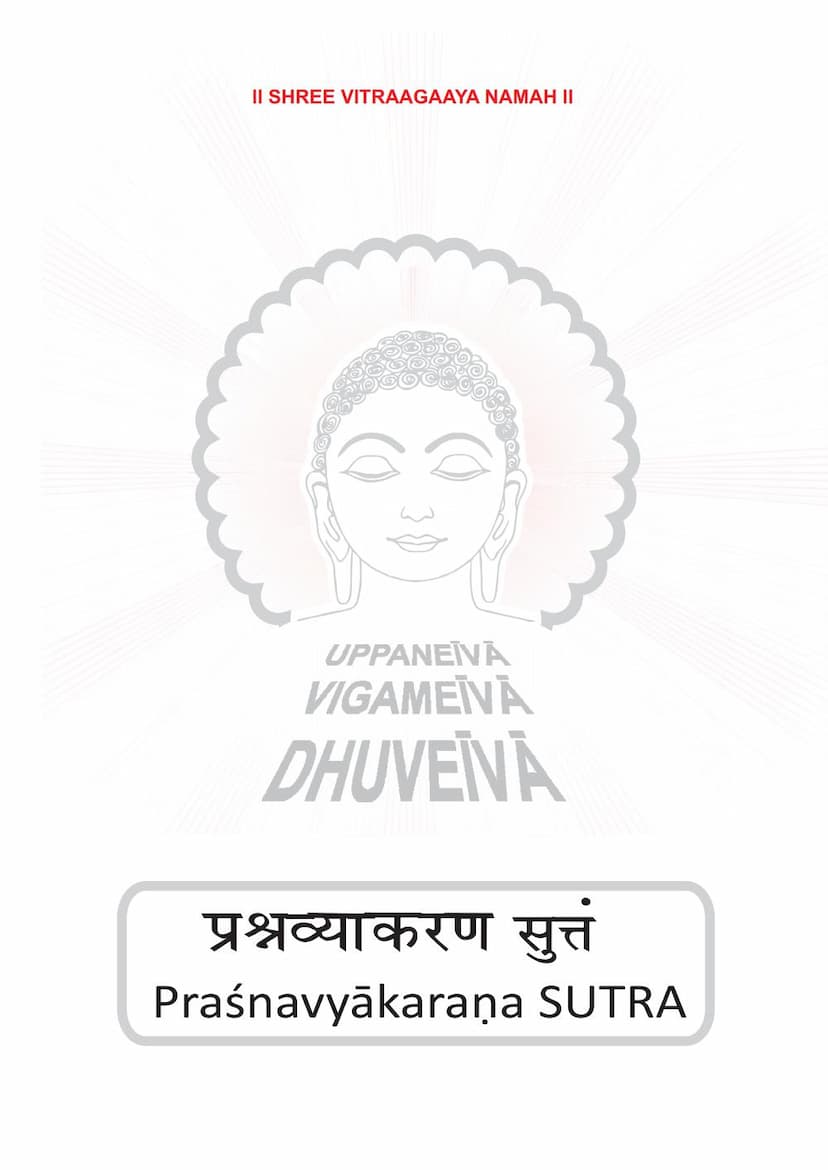Agam 10 Ang 10 Prashna Vyakaran Sutra Mool Sthanakvasi
Added to library: September 1, 2025

Summary
Here's a comprehensive summary of the Jain text "Praśnavyākaraṇa Sūtra," based on the provided pages:
Title: Praśnavyākaraṇa Sūtra (प्रश्नव्याकरण सुत्तं)
Authorship:
- Attributed to Sudharmaswami, the fifth Ganadhara (disciple) of Bhagwan Mahāvīra.
- The text was later clarified and edited by Devarddhigani Kshamashaman, who chaired the Vallabhi Council.
Publisher: Global Jain Agam Mission.
Nature of the Text:
- It is the 10th Anga Agama of the Jain canon.
- The original text is in Ardhamāgadhi aphorisms.
- It is considered a compilation of Bhagwan Mahāvīra's precepts.
Structure of the Text (as presented in the table of contents): The text is divided into two major sections called Suyakhandas (सुयखंध):
-
Āsavadāra (आसवदार): This section deals with the "doors of influx" of karma into the soul. It outlines the various ways karma binds the soul.
- It is further divided into five chapters (Adhyayanas - अध्ययना), each focusing on a specific aspect of Āsava:
- Hiṃsā (हिंसा): Violence, harm, or injury to living beings.
- Mr̥ṣāvāda (मृषावाद): Falsehood, lying, or untruthful speech.
- Adinnādāna (अदिण्णादाणं): Taking what is not given; theft.
- Abrahma (अबंभ): Unchastity or lack of celibacy.
- Parigraha (परिग्गहो): Attachment or possession, greed.
- It is further divided into five chapters (Adhyayanas - अध्ययना), each focusing on a specific aspect of Āsava:
-
Saṃvaradāra (संवरदार): This section focuses on "Saṃvara," the stopping or restraint of the influx of karma. It details the practices that prevent karmic bondage.
- This section also has five chapters (Adhyayanas - अध्ययना), mirroring the Āsava aspects:
- Ahiṃsā (अहिंसा): Non-violence.
- Sacvavachana (सच्चवयणं): Truthful speech.
- Dattamannuṇṇāya (दत्तमणुण्णाय): Giving or charity (understood as a form of restraint).
- Brahmacarya (ब्रह्मचर्य): Celibacy or pure conduct.
- Aparigraha (अपरिग्गह): Non-attachment or non-possession.
- This section also has five chapters (Adhyayanas - अध्ययना), mirroring the Āsava aspects:
Key Themes and Content Highlights:
-
Āsava (Influx of Karma): The first major part of the text systematically details the five fundamental causes of karmic influx (Hiṃsā, Mr̥ṣāvāda, Adinnādāna, Abrahma, Parigraha). Each section elaborates on the nature of these actions, their various forms, the motivations behind them, and the severe consequences that follow in this life and future lives, including detailed descriptions of the hellish realms and the suffering experienced there.
- Violence (Hiṃsā): The text provides extensive lists of various living beings (aquatic, terrestrial, aerial) and the methods by which they are harmed or killed, emphasizing the detrimental impact of such actions.
- Falsehood (Mr̥ṣāvāda): It describes different types of lies and deceptive speech, highlighting the negative outcomes associated with them. It also touches upon atheistic or nihilistic views that deny the existence of soul, karma, or afterlife as forms of falsehood.
- Theft (Adinnādāna): The text details various forms of stealing and illicit gain, including the actions of thieves, merchants who cheat, and rulers who unjustly tax their subjects. It elaborates on the suffering resulting from these acts.
- Unchastity (Abrahma): This section discusses the consequences of sensual indulgence and broken celibacy, emphasizing its disruptive nature to spiritual practice and the severe repercussions.
- Attachment/Greed (Parigraha): The text explains how excessive attachment to possessions, wealth, relationships, and even spiritual knowledge becomes a source of karmic influx and suffering.
-
Saṃvara (Restraint of Karma): The second major part focuses on the practices that counteract and prevent the influx of karma. It emphasizes the importance of the five great vows (Mahavratas) and the five restraints (Samitis) for achieving liberation.
- Non-violence (Ahiṃsā): Presented as the foremost virtue and the foundation of Jain practice. It stresses the importance of non-violence towards all living beings in thought, word, and deed. The text lists various virtues and qualities that arise from practicing non-violence. It outlines specific guidelines for monks regarding the collection of food and resources, emphasizing purity and harmlessness.
- Truthfulness (Sacvavachana): The text highlights the power and importance of truth, describing how it can lead to liberation. It also cautions against speaking harsh, divisive, or untruthful words, even if they appear to be true.
- Charity/Giving (Dattamannuṇṇāya): This is understood in the context of restraint, likely referring to giving up what is not rightfully yours and practicing righteous giving. It emphasizes the importance of virtuous giving and the pitfalls of ill-gotten gains.
- Celibacy/Pure Conduct (Brahmacarya): This section elaborates on the importance of chastity and control over senses, detailing the temptations and distractions that hinder this practice and how to overcome them.
- Non-attachment (Aparigraha): This is presented as the ultimate state of restraint, where one gives up all forms of possession and attachment, leading to liberation from worldly suffering.
-
The Role of the Global Jain Agam Mission: The publisher's pages highlight their mission to translate and disseminate Jain Agamas worldwide, aiming to make Lord Mahāvīra's teachings accessible to a global audience. They emphasize the importance of understanding these scriptures for a compassionate and nonviolent lifestyle and encourage scholarly research and participation in their project.
Overall Purpose: The Praśnavyākaraṇa Sūtra serves as a foundational text in Jainism, providing a detailed understanding of the karmic process, its causes (Āsava), and the remedies for spiritual purification and liberation (Saṃvara). It offers practical guidance for adhering to the principles of Jainism through the practice of right faith, knowledge, and conduct. The text's detailed descriptions of suffering are intended to motivate adherence to virtuous practices for achieving ultimate bliss and liberation.